Key takeaways:
- Culturally responsive teaching bridges students’ identities with the curriculum, fostering engagement and inclusivity through cultural context.
- Music education enhances social and emotional growth, teamwork, cognitive abilities, and cultural awareness, acting as a powerful educational tool.
- Successful integration of diverse music involves creating a welcoming environment, using culturally relevant examples, and collaborating with local musicians for authenticity.
- Reflecting on teaching practices is essential to creating inclusive environments, valuing diverse strengths, and adapting assessment methods to highlight students’ cultural heritages.
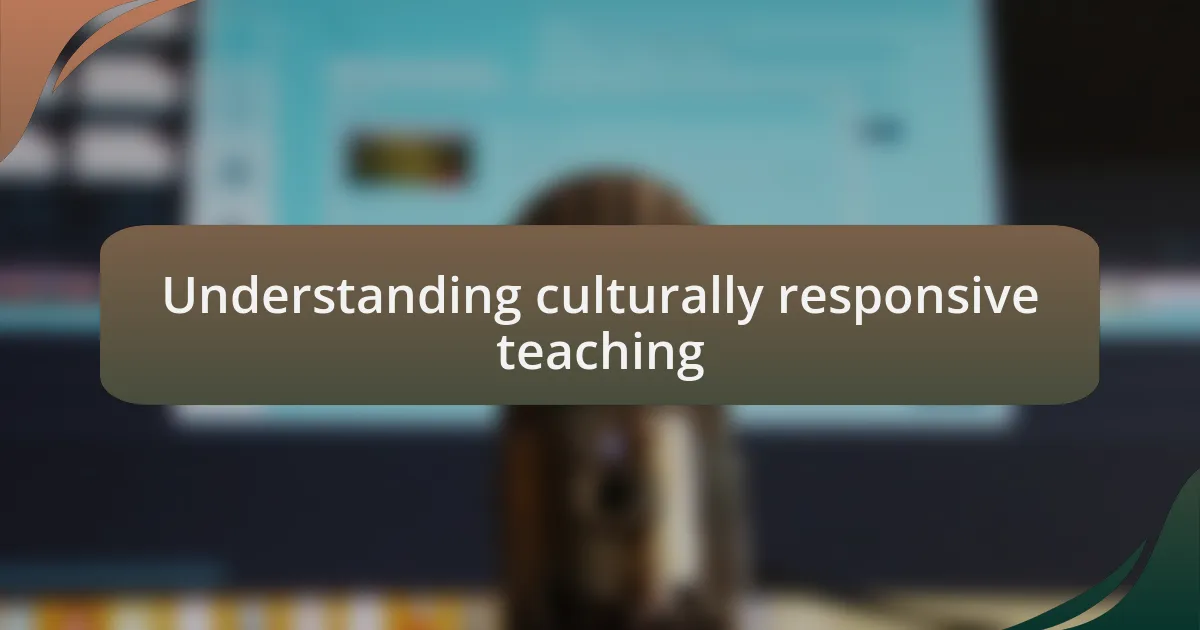
Understanding culturally responsive teaching
Understanding culturally responsive teaching begins with recognizing the diverse backgrounds students bring into the classroom. I remember my first experience integrating students’ cultural contexts into lessons; it was eye-opening to see how music that resonated with their heritage sparked engagement and passion. Have you ever noticed how certain melodies can evoke strong memories or feelings tied to one’s culture?
At its core, culturally responsive teaching is about building bridges between students’ identities and the curriculum. It’s not just about celebrating diversity, but also about validating each student’s unique narrative. For instance, I once collaborated with students from various backgrounds to compose a piece that blended their musical traditions. This collaboration deepened their connection to the material and fostered a sense of belonging.
Furthermore, understanding culturally responsive teaching involves ongoing reflection and adaptation. I often ask myself how well I am embracing my students’ diverse experiences and biases in my teaching. It’s a continuous process that encourages us to question our methods and seek out new ways to engage all learners meaningfully. What strategies have you found effective in making your teaching more inclusive?
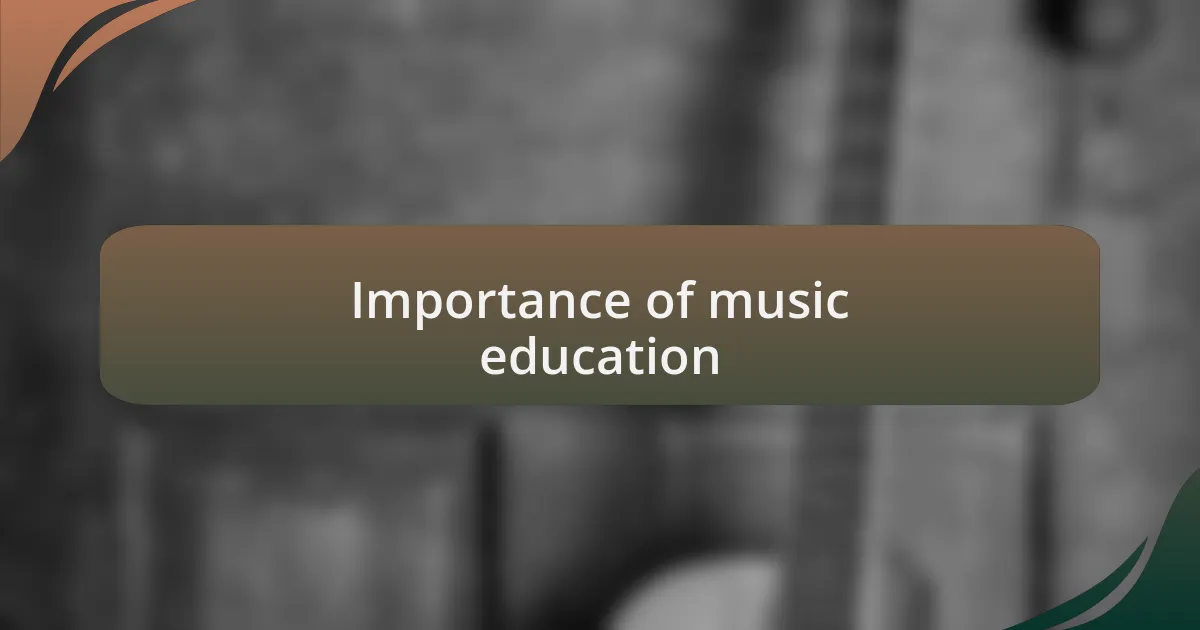
Importance of music education
Music education is vital in shaping not only musical skills but also social and emotional growth. I recall a student who struggled with self-expression, finding it difficult to communicate. When they picked up an instrument for the first time, it was like a door opened; through music, they discovered a voice that felt authentic. How might the transformative power of music unlock potential in other students?
Moreover, engaging in music education fosters teamwork and collaboration. During a group project where students arranged a song together, I witnessed contrasting ideas blossoming into a beautiful harmony. The excitement in their eyes when they realized they could create something greater together was priceless. Have you ever seen a classroom unite through music?
Lastly, music education plays a crucial role in enhancing cognitive abilities and cultural awareness. Research shows that learning music can improve memory and critical thinking skills. I’ve seen students draw parallels between musical structures and math concepts, bridging gaps in understanding. Isn’t it incredible how music can serve as both an artistic endeavor and a powerful educational tool?
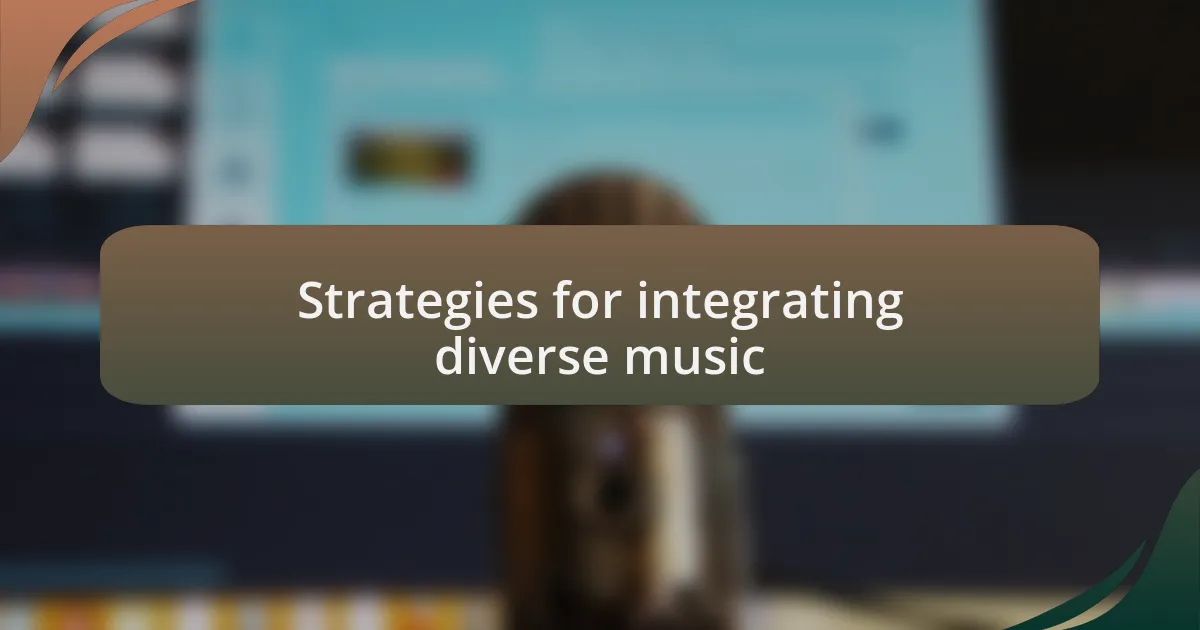
Strategies for integrating diverse music
Incorporating diverse music into the curriculum begins with creating a welcoming environment where all cultures are celebrated. Last year, I introduced a unit on global music traditions, and the excitement among my students was palpable. They eagerly shared songs from their backgrounds, making it a bonding experience that deepened their appreciation for each other’s heritage. How often do we take the time to recognize the rich tapestries of music that surround us?
Another effective strategy lies in using culturally relevant examples that connect with students’ lives. For instance, I once played hip-hop tracks that highlighted historical events, sparking fascinating discussions about cultural identity and expression. Seeing their eyes light up when discussing the artists’ narratives made me realize the impact of music as a vehicle for storytelling. Isn’t it fascinating how a simple song can bridge generational and cultural gaps?
Finally, collaboration with local musicians from diverse backgrounds can bring authenticity to the classroom experience. I invited a percussionist to demonstrate traditional African rhythms, and the students were so engaged that they jumped at the chance to try their hand at drumming. This hands-on experience not only energized the lesson but also fostered an appreciation for the richness of cultural influences in music. Have you ever felt the rhythm of a people resonate within your own heart?
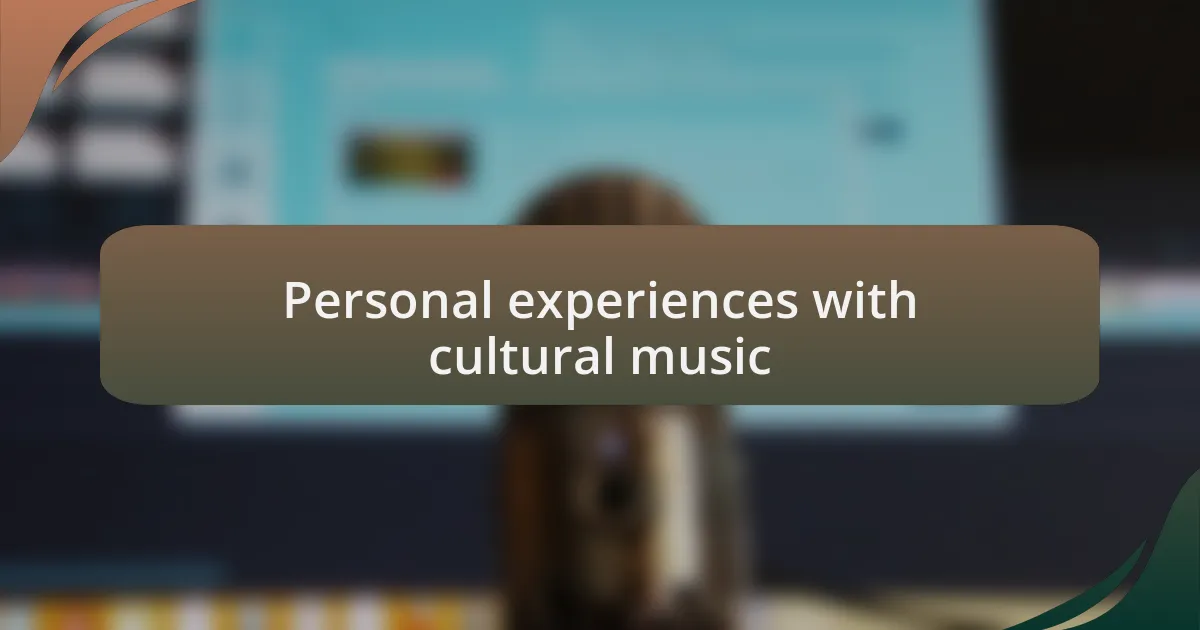
Personal experiences with cultural music
When I reflect on my early experiences with cultural music, one moment stands out vividly. At a family gathering, my uncle played traditional Mexican mariachi songs that filled the air with life and stories. I remember feeling a deep connection to my roots as the vibrant melodies carried memories of past celebrations, a reminder of how music can strengthen our bonds to culture.
In my college years, I participated in a summer program focused on African drumming. The rhythms I learned were not just patterns; they were narratives of love, struggle, and community. I found myself immersed in the culture, feeling every beat resonate within me. It was a transformative experience, showing me that music transcends mere entertainment and serves as a reflection of collective identity.
More recently, I attended a concert featuring a blend of classical and Indigenous music. The performance was breathtaking, with the artists intertwining their musical traditions to create something uniquely beautiful. It made me wonder how often we overlook the power of collaboration in music. Witnessing such an experience reinforced my belief that each cultural sound has a place in creating a shared musical dialogue.
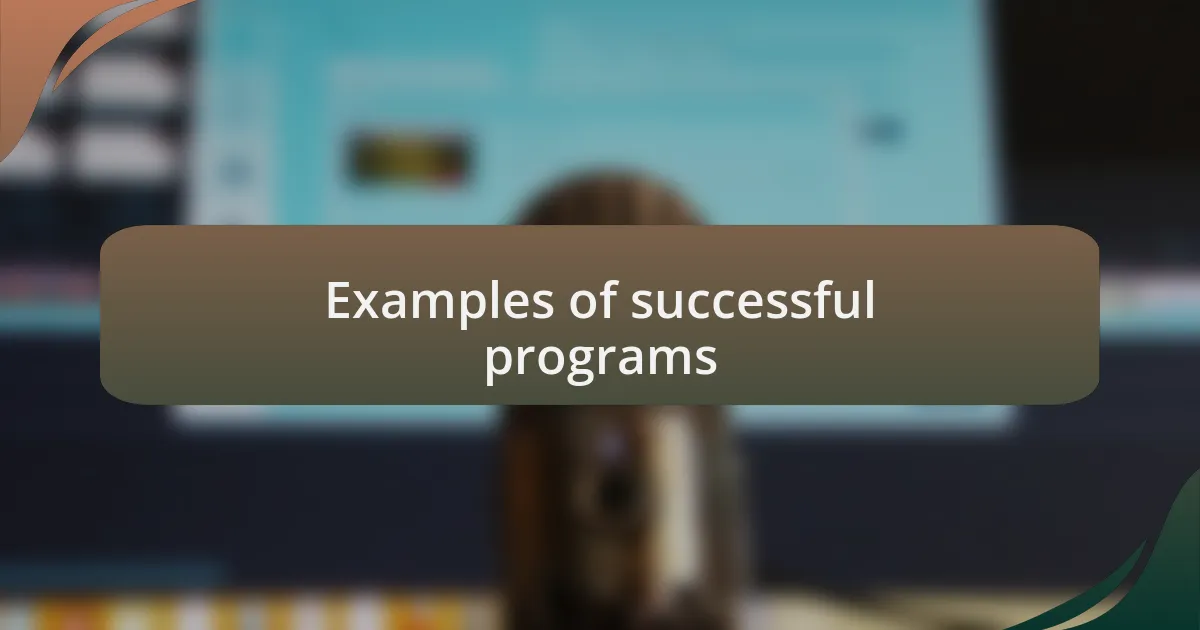
Examples of successful programs
When I think about successful culturally responsive teaching programs, one that comes to mind is the neighborhood youth orchestra I worked with. It was remarkable to see how the inclusion of music from diverse backgrounds not only enriched the curriculum but also fostered a sense of belonging among the students. Watching them perform a blend of Beethoven and traditional African melodies was heartwarming; it showed me how powerful it is to celebrate differences through music.
Another standout program was a community drum circle that I facilitated. Participants brought their own styles and instruments, creating a rich tapestry of sound that was both spontaneous and deeply meaningful. I could feel the palpable joy in the air as people discovered commonalities within their varied musical expressions. It made me realize that music education can serve as a bridge, connecting individuals from different walks of life in profound ways.
One particularly successful initiative I came across was an after-school program dedicated to Latin music. In this program, students learned not only how to play instruments but also the history behind the genres, like salsa and cumbia. It was a joy to see their eyes light up as they understood the stories and emotions embedded in each rhythm. I often wonder if other music education programs could benefit from such an approach, where the cultural context enhances the learning experience.
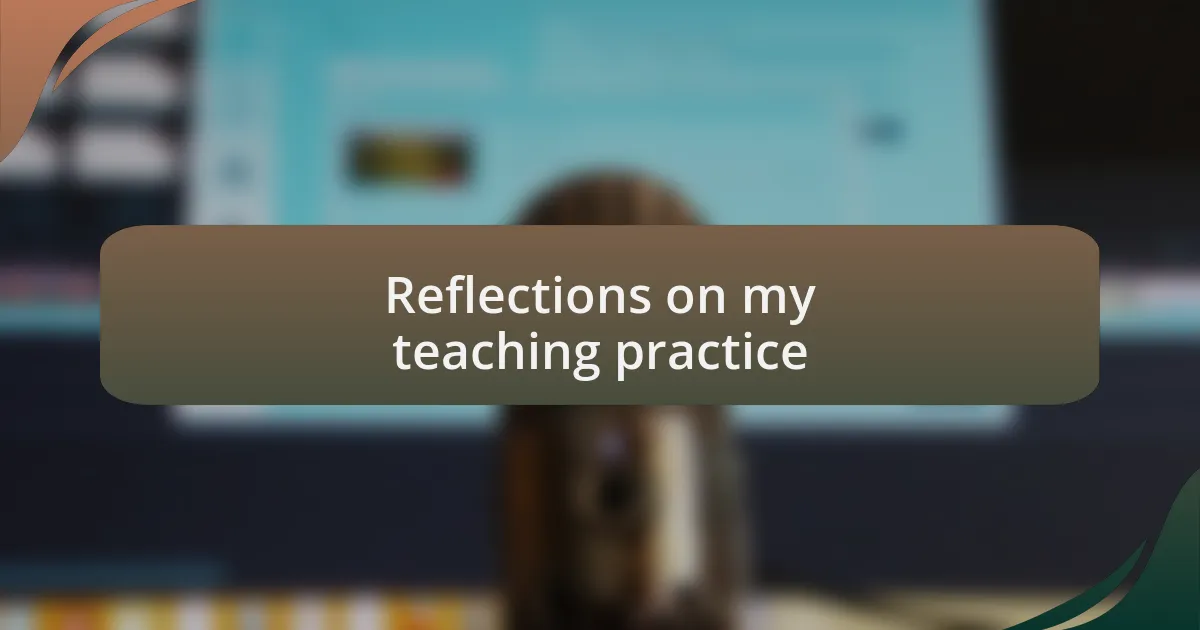
Reflections on my teaching practice
Reflecting on my teaching practice, I realize how vital it is to create an inclusive environment where every student feels acknowledged. Just last semester, I incorporated a unit on hip-hop into my curriculum. The shift in energy was palpable; students who typically shied away from participation started to share their own lyrical compositions. Isn’t it interesting how tapping into their cultural roots can ignite passion and creativity?
In another instance, I had a student who struggled with traditional Western notation. After discussing his background and experiences with regional folk music, I adapted my instruction to leverage his familiarity with oral traditions. The moment he successfully applied those concepts to his guitar playing was unforgettable. How often do we overlook the unique strengths of our students?
This reflection has led me to reconsider assessment methods as well. Instead of relying solely on standard tests, I’ve begun to value performances that incorporate cultural elements. I often ask myself, how can I ensure that every student’s voice is heard? Creating opportunities for them to showcase their heritage not only enriches their learning but also deepens our collective musical experience in the classroom.